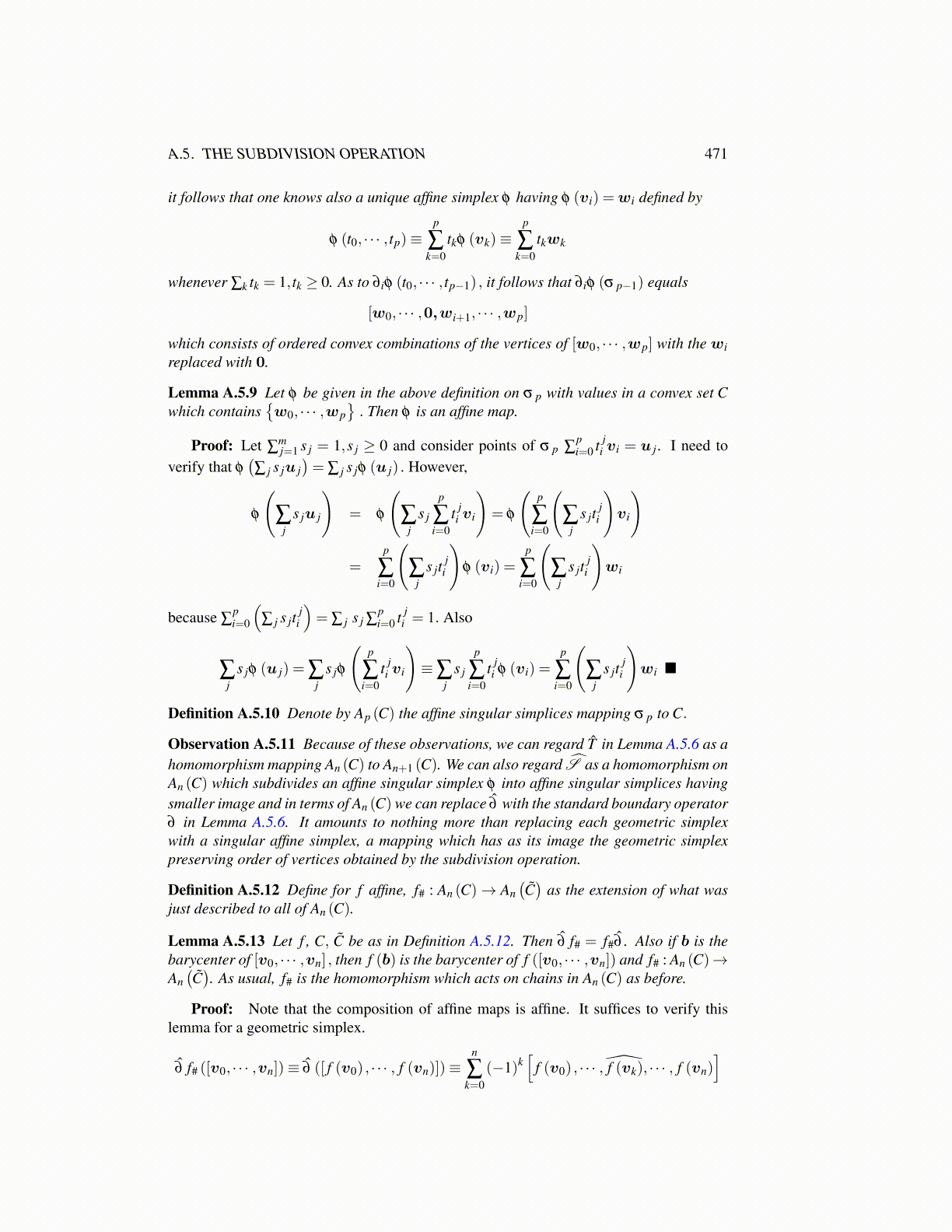
A.5. THE SUBDIVISION OPERATION 471
it follows that one knows also a unique affine simplex φ having φ (vi) =wi defined by
φ (t0, · · · , tp)≡p
∑k=0
tkφ (vk)≡p
∑k=0
tkwk
whenever ∑k tk = 1, tk ≥ 0. As to ∂iφ (t0, · · · , tp−1) , it follows that ∂iφ (σ p−1) equals
[w0, · · · ,0,wi+1, · · · ,wp]
which consists of ordered convex combinations of the vertices of [w0, · · · ,wp] with the wireplaced with 0.
Lemma A.5.9 Let φ be given in the above definition on σ p with values in a convex set Cwhich contains
{w0, · · · ,wp
}. Then φ is an affine map.
Proof: Let ∑mj=1 s j = 1,s j ≥ 0 and consider points of σ p ∑
pi=0 t j
i vi = u j. I need toverify that φ
(∑ j s ju j
)= ∑ j s jφ (u j) . However,
φ
(∑
js ju j
)= φ
(∑
js j
p
∑i=0
t ji vi
)= φ
(p
∑i=0
(∑
js jt
ji
)vi
)
=p
∑i=0
(∑
js jt
ji
)φ (vi) =
p
∑i=0
(∑
js jt
ji
)wi
because ∑pi=0
(∑ j s jt
ji
)= ∑ j s j ∑
pi=0 t j
i = 1. Also
∑j
s jφ (u j) = ∑j
s jφ
(p
∑i=0
t ji vi
)≡∑
js j
p
∑i=0
t ji φ (vi) =
p
∑i=0
(∑
js jt
ji
)wi ■
Definition A.5.10 Denote by Ap (C) the affine singular simplices mapping σ p to C.
Observation A.5.11 Because of these observations, we can regard T̂ in Lemma A.5.6 as ahomomorphism mapping An (C) to An+1 (C). We can also regard Ŝ as a homomorphism onAn (C) which subdivides an affine singular simplex φ into affine singular simplices havingsmaller image and in terms of An (C) we can replace ∂̂ with the standard boundary operator∂ in Lemma A.5.6. It amounts to nothing more than replacing each geometric simplexwith a singular affine simplex, a mapping which has as its image the geometric simplexpreserving order of vertices obtained by the subdivision operation.
Definition A.5.12 Define for f affine, f# : An (C)→ An(C̃)
as the extension of what wasjust described to all of An (C).
Lemma A.5.13 Let f , C, C̃ be as in Definition A.5.12. Then ∂̂ f# = f#∂̂ . Also if b is thebarycenter of [v0, · · · ,vn] , then f (b) is the barycenter of f ([v0, · · · ,vn]) and f# : An (C)→An(C̃). As usual, f# is the homomorphism which acts on chains in An (C) as before.
Proof: Note that the composition of affine maps is affine. It suffices to verify thislemma for a geometric simplex.
∂̂ f# ([v0, · · · ,vn])≡ ∂̂ ([ f (v0) , · · · , f (vn)])≡n
∑k=0
(−1)k[
f (v0) , · · · , f̂ (vk), · · · , f (vn)]